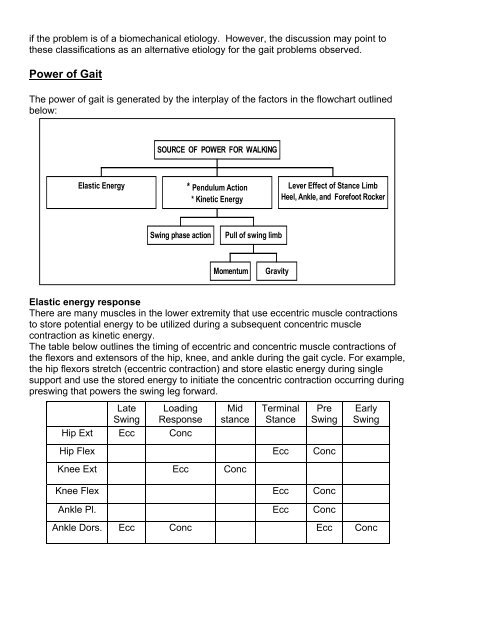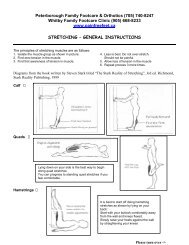Gait Analysis Handout - painfreefeet.ca
Gait Analysis Handout - painfreefeet.ca
Gait Analysis Handout - painfreefeet.ca
You also want an ePaper? Increase the reach of your titles
YUMPU automatically turns print PDFs into web optimized ePapers that Google loves.
if the problem is of a biomechani<strong>ca</strong>l etiology. However, the discussion may point to<br />
these classifi<strong>ca</strong>tions as an alternative etiology for the gait problems observed.<br />
Power of <strong>Gait</strong><br />
The power of gait is generated by the interplay of the factors in the flowchart outlined<br />
below:<br />
Elastic Energy<br />
Elastic energy response<br />
There are many muscles in the lower extremity that use eccentric muscle contractions<br />
to store potential energy to be utilized during a subsequent concentric muscle<br />
contraction as kinetic energy.<br />
The table below outlines the timing of eccentric and concentric muscle contractions of<br />
the flexors and extensors of the hip, knee, and ankle during the gait cycle. For example,<br />
the hip flexors stretch (eccentric contraction) and store elastic energy during single<br />
support and use the stored energy to initiate the concentric contraction occurring during<br />
preswing that powers the swing leg forward.<br />
Late<br />
Swing<br />
Loading<br />
Response<br />
Hip Ext Ecc Conc<br />
SOURCE OF POWER FOR WALKING<br />
Swing phase action<br />
* Pendulum Action<br />
* Kinetic Energy<br />
Mid<br />
stance<br />
Terminal<br />
Stance<br />
Pre<br />
Swing<br />
Hip Flex Ecc Conc<br />
Knee Ext Ecc Conc<br />
Pull of swing limb<br />
Momentum Gravity<br />
Lever Effect of Stance Limb<br />
Heel, Ankle, and Forefoot Rocker<br />
Knee Flex Ecc Conc<br />
Ankle Pl. Ecc Conc<br />
Early<br />
Swing<br />
Ankle Dors. Ecc Conc Ecc Conc



